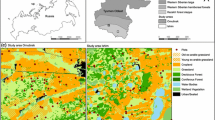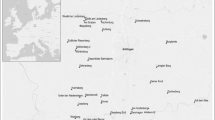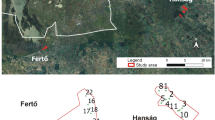Abstract
Semi-natural grassland supports a large proportion of biodiversity and ecosystem services in Europe, however, it is continuing to be destroyed or degraded. In addition to the clear role of local management in these processes, there is increasing evidence for wider landscape-scale effects on species richness and community composition of plants and animals. Most of this evidence comes from studies in highly altered western European landscapes with only fragments of remaining semi-natural grassland. In contrast, Eastern European countries such as Romania still contain large areas of semi-natural grassland, but this habitat is threatened by agricultural intensification and homogenization. We analyzed vascular plant and Orthoptera communities from species-rich pastures in Southern Transylvania, Romania, against a range of local and landscape factors. Species richness of plants had a highly significant positive relationship with landscape heterogeneity. Orthoptera species richness and abundance were negatively correlated with plant species richness, and increased with proportion of grassland in the landscape and local vegetation height. The results suggest that large and species-rich grassland communities can be significantly affected by both local and landscape scale land use changes, but effects can vary within and between taxonomic groups. Conservation measures such as agri-environment schemes should therefore seek to address landscape scale processes better, promoting a range of low-intensity land use practices in order to support a variety of landscape types.

Similar content being viewed by others
References
Aavik T, Augenstein I, Bailey D, Herzog F, Zobel M, Liira J (2008) What is the role of local landscape structure in the vegetation composition of field boundaries? Appl Veg Sci 11:375–386. doi:10.3170/2008-7-18486
Báldi A, Batáry P (2011) Spatial heterogeneity and farmland birds: different perspectives in Western and Eastern Europe. Ibis 153:875–876. doi:10.1111/j.1474-919X.2011.01169.x
Batáry P, Báldi A, Szél G, Podlussány A, Rozner I, Erdős S (2007a) Responses of grassland specialist and generalist beetles to management and landscape complexity. Divers Distrib 13:196–202. doi:10.1111/j.1472-4642.2006.00309.x
Batáry P, Orci KM, Báldi A, Kleijn D, Kisbenedek T, Erdős S (2007b) Effects of local and landscape scale and cattle grazing intensity on Orthoptera assemblages of the Hungarian Great Plain. Basic Appl Ecol 8:280–290. doi:10.1016/j.baae.2006.03.012
Batáry P, Báldi A, Kleijn D, Tscharntke T (2010) Landscape-moderated biodiversity effects of agri-environmental management: a meta-analysis. Proc R Soc B Biol Sci 278:1894–1902. doi:10.1098/rspb.2010.1923
Batáry P, Sutcliffe LME, Dormann CF, Tscharntke T (2013) Organic farming favours insect-pollinated over non-insect pollinated forbs in meadows and wheat fields. PLoS ONE 8:e54818. doi:10.1371/journal.pone.0054818
Bates D, Maechler M, Bolker BM, Walker S (2014). lme4: Linear mixed-effects models using Eigen and S4. R package version 1.0-6. http://CRAN.R-project.org/package=lme4
Becker T, Brändel M (2007) Vegetation-environment relationships in a heavy metal-dry grassland complex. Folia Geobot 42:11–28
Bullock JM, Jefferson RG, Blackstock TH, et al. (2011) Semi-natural Grasslands. UK Natl Ecosyst Assess Tech Rep UNEP-WCMC, Cambridge, pp 161–196
Chytrý M, Tichý L, Role J (2003) Local and regional patterns of species richness in central european vegetation types along the ph/calcium gradient. Folia Geobot 38:429–442
Concepción ED, Díaz M, Baquero RA (2008) Effects of landscape complexity on the ecological effectiveness of agri-environment schemes. Landsc Ecol 23:135–148. doi:10.1007/s10980-007-9150-2
Cousins SAO, Aggemyr E (2008) The influence of field shape, area and surrounding landscape on plant species richness in grazed ex-fields. Biol Conserv 141:126–135. doi:10.1016/j.biocon.2007.09.004
Dauber J, Hirsch M, Simmering D, Waldhardt R, Otte A, Wolters V (2003) Landscape structure as an indicator of biodiversity: matrix effects on species richness. Agric Ecosyst Environ 98:321–329. doi:10.1016/S0167-8809(03)00092-6
EEA (2010) EU 2010 biodiversity baseline. European Environment Agency, Copenhagen. doi:10.2800/6160
Ellenberg H, Leuschner C (2010) Vegetation mitteleuropas mit den alpen, 6th edn. Verlag Eugen Ulmer, Stuttgart
Essl F, Dirnböck T (2012) What determines Orthoptera species distribution and richness in temperate semi-natural dry grassland remnants? Biodivers Conserv 21:2525–2537. doi:10.1007/s10531-012-0315-1
Fahrig L (2013) Rethinking patch size and isolation effects: the habitat amount hypothesis. J Biogeogr 40:1649–1663. doi:10.1111/jbi.12130
Fahrig L, Baudry J, Brotons L, Burel FG, Crist TO, Fuller RJ, Sirami C, Siriwardena G, Martin J-L (2010) Functional landscape heterogeneity and animal biodiversity in agricultural landscapes. Ecol Lett 14:101–112. doi:10.1111/j.1461-0248.2010.01559.x
Fartmann T, Krämer B, Stelzner F, Poniatowski D (2012) Orthoptera as ecological indicators for succession in steppe grassland. Ecol Indic 20:337–344. doi:10.1016/j.ecolind.2012.03.002
Fuentes-Montemayor E, Goulson D, Park KJ (2011) Pipistrelle bats and their prey do not benefit from four widely applied agri-environment management prescriptions. Biol Conserv 144:2233–2246. doi:10.1016/j.biocon.2011.05.015
Gardiner T, Hill J, Chesmore D (2005) Review of the methods frequently used to estimate the abundance of Orthoptera in grassland ecosystems. J Insect Conserv 9:151–173. doi:10.1007/s10841-005-2854-1
Harz K (1969) Die Orthopteren Europas 1. W. Junk Publishers, The Hague
Harz K (1975) Die Orthopteren Europas 2. W. Junk Publishers, The Hague
Heard MS, Carvell C, Carreck NL, Rothery P, Osborne JL, Bourke AFG (2007) Landscape context not patch size determines bumble-bee density on flower mixtures sown for agri-environment schemes. Biol Lett 3:638–641. doi:10.1098/rsbl.2007.0425
Helm A, Hanski I, Pärtel M (2006) Slow response of plant species richness to habitat loss and fragmentation. Ecol Lett 9:72–77
Hiron M, Berg Å, Eggers S, Josefsson J, Pärt T (2013) Bird diversity relates to agri-environment schemes at local and landscape level in intensive farmland. Agric Ecosyst Environ 176:9–16. doi:10.1016/j.agee.2013.05.013
Holzschuh A, Steffan-Dewenter I, Tscharntke T (2010) How do landscape composition and configuration, organic farming and fallow strips affect the diversity of bees, wasps and their parasitoids? J Anim Ecol 79:491–500. doi:10.1111/j.1365-2656.2009.01642.x
Iorgu IS, Iorgu EI (2008) Bush-crickets, crickets and grasshoppers from Moldavia (Romania). PIM, Iasi
Iorgu IS, Pisica E, Pais L, et al. (2008) Checklist of Romanian Orthoptera (Insecta) and their distribution by eco-regions. Trav du Muséum Natl d’Histoire Nat « Grigore Antipa » 51:119–135
Jakobsson A, Eriksson O (2000) A comparative study of seed number, seed size, seedling size and recruitment in grassland plants. Oikos 88:494–502. doi:10.1034/j.1600-0706.2000.880304.x
Janišová M, Michalcová D, Bacaro G, Ghisla A (2013) Landscape effects on diversity of semi-natural grasslands. Agric Ecosyst Environ. doi:10.1016/j.agee.2013.05.022
Janssens F, Peeters A, Tallowin JRB, Bakker JP, Bekker RM, Fillat F, Oomes MJM (1998) Relationship between soil chemical factors and grassland diversity. Plant Soil 202:69–78
Joern A (1979) Feeding patterns in grasshoppers (Orthoptera: Acrididae): factors influencing diet specialization. Oecologia 38:325–347
Jonason D, Andersson GKS, Ockinger E, Maj R, Smith HG, Bengtsson J (2011) Assessing the effect of the time since transition to organic farming on plants and butterflies. J Appl Ecol 48:543–550. doi:10.1111/j.1365-2664.2011.01989.x
Kati V, Zografou K, Tzirkalli E, Chitos T, Willemse L (2012) Butterfly and grasshopper diversity patterns in humid Mediterranean grasslands: the roles of disturbance and environmental factors. J Insect Conserv 16:807–818. doi:10.1007/s10841-012-9467-2
Kis B (1976) Cheie pentru determinarea Orthopterelor din Romania Partea I. Subordinul Ensifera. Muzeul Brukenthal Stiintele Naturii—Studii si Comunicari 20:123–166
Kis B (1978) Cheie pentru determinarea Orthopterelor din Romania Partea II. Subordinul Caelifera. Muzeul Brukenthal Stiintele Naturii - Studii si Comunicari 22:233–276
Klotz S, Kühn I, Durka W (2002) BIOLFLOR—Eine Datenbank zu biologisch-ökologischen Merkmalen der Gefäßpflanzen in Deutschland. Schriftenr. für Veg. 38, Bundesamt für Naturschutz, Bonn
Konvička M, Benes J, Cizek O, Kopecek F, Konvička O, Vitaz L (2007) How too much care kills species: grassland reserves, agri-environmental schemes and extinction of Colias myrmidone (Lepidoptera: Pieridae) from its former stronghold. J Insect Conserv 12:519–525. doi:10.1007/s10841-007-9092-7
Koper N, Nudds TD (2011) Progress in research on grassland bird conservation and ecology. Avian Conserv Ecol 6:6. doi:10.5751/ACE-00461-060106
Kőrösi Á, Batáry P, Orosz A, Rédei D, Báldi A (2012) Effects of grazing, vegetation structure and landscape complexity on grassland leafhoppers (Hemiptera: Auchenorrhyncha) and true bugs (Hemiptera: Heteroptera) in Hungary. Insect Conserv Divers 5:57–66. doi:10.1111/j.1752-4598.2011.00153.x
Kovács-Hostyánszki A, Kőrösi Á, Orci KM, Batáry P, Báldi A (2011) Set-aside promotes insect and plant diversity in a Central European country. Agric Ecosyst Environ 141:296–301. doi:10.1016/j.agee.2011.03.004
Krauss J, Klein A-M, Steffan-Dewenter I, Tscharntke T (2004) Effects of habitat area, isolation, and landscape diversity on plant species richness of calcareous grasslands. Biodivers Conserv 13:1427–1439. doi:10.1023/B:BIOC.0000021323.18165.58
Krauss J, Bommarco R, Guardiola M et al (2010) Habitat fragmentation causes immediate and time-delayed biodiversity loss at different trophic levels. Ecol Lett 13:597–605. doi:10.1111/j.1461-0248.2010.01457.x
Landolt E, Bäumler B, Erhardt A et al (2010) Flora indicativa: ökologische Zeigerwerte und biologische Kennzeichen zur Flora der Schweiz und der Alpen (Ecological indicator values and biological attributes of the flora of Switzerland and the Alps), 1st edn. Haupt, Bern
Legendre P, Gallagher E (2001) Ecologically meaningful transformations for ordination of species data. Oecologia 129:271–280. doi:10.1007/s004420100716
Lindborg R, Eriksson O (2004) Historical landscape connectivity affects present plant species diversity. Ecology 85:1840–1845
Lindborg R, Helm A, Bommarco R, Heikkinen RK, Kühn I, Pykälä J, Pärtel M (2012) Effect of habitat area and isolation on plant trait distribution in European forests and grasslands. Ecography 35:356–363. doi:10.1111/j.1600-0587.2011.07286.x
Löbel S, Dengler J, Hobohm C (2006) Species richness of vascular plants, bryophytes and lichens in dry grasslands: the effects of environment, landscape structure and competition. Folia Geobot 41:377–393
Marini L, Fontana P, Scotton M, Klimek S (2008) Vascular plant and Orthoptera diversity in relation to grassland management and landscape composition in the European Alps. J Appl Ecol 45:361–370. doi:10.1111/j.1365-2664.2007.01402.x
Marini L, Bommarco R, Fontana P, Battisti A (2010) Disentangling effects of habitat diversity and area on orthopteran species with contrasting mobility. Biol Conserv 143:2164–2171. doi:10.1016/j.biocon.2010.05.029
McCune B, Keon D (2009) Equations for potential annual direct incident radiation and heat load. J Veg Sci 13:603–606. doi:10.1111/j.1654-1103.2002.tb02087.x
McKenzie AJ, Emery SB, Franks JR, Whittingham MJ (2013) Landscape-scale conservation: collaborative agri-environment schemes could benefit both biodiversity and ecosystem services, but will farmers be willing to participate? J Appl Ecol 50:1274–1280. doi:10.1111/1365-2664.12122
Öckinger E, Lindborg R, Sjödin NE, Bommarco R (2012) Landscape matrix modifies richness of plants and insects in grassland fragments. Ecography 35:259–267. doi:10.1111/j.1600-0587.2011.06870.x
Oksanen J, Blanchet FG, Kindt R, et al. (2013) Vegan: community ecology package, R package version 2.0–6
Oroian S, Hiriţiu M, Curticăpean M (2007) The xero-mezophylic and xerophylic grasslands of Festuco–Brometea class in the Sighişoara - Tarnava mare potential Natura 2000 site (Transylvania, Romania). Transylv Rev Syst Ecol Res 3:83–126
Öster M, Cousins SAO, Eriksson O (2007) Size and heterogeneity rather than landscape context determine plant species richness in semi-natural grasslands. J Veg Sci 18:859–868
Pärtel M, Kalamees R, Reier Ü, Tuvi E-L, Roosaluste E, Vellak A, Zobel M (2005) Grouping and prioritization of vascular plant species for conservation: combining natural rarity and management need. Biol Conserv 123:271–278. doi:10.1016/j.biocon.2004.11.014
Poschlod P, Wallis De Vries MF (2002) The historical and socioeconomic perspective of calcareous grasslands—lessons from the distant and recent past. Biol Conserv 104:361–376. doi:10.1016/S0006-3207(01)00201-4
Power EF, Kelly DL, Stout JC (2012) Organic farming and landscape structure: effects on insect-pollinated plant diversity in intensively managed grasslands. PLoS ONE 7:e38073. doi:10.1371/journal.pone.0038073
Prevedello JA, Vieira MV (2010) Does the type of matrix matter? A quantitative review of the evidence. Biodivers Conserv 19:1205–1223. doi:10.1007/s10531-009-9750-z
R Core Team (2013) R: a language and environment for statistical computing. R Foundation for Statistical Computing, Vienna
Raatikainen KM, Heikkinen RK, Luoto M (2008) Relative importance of habitat area, connectivity, management and local factors for vascular plants: spring ephemerals in boreal semi-natural grasslands. Biodivers Conserv 18:1067–1085. doi:10.1007/s10531-008-9462-9
Reif J, Böhning-Gaese K, Flade M, Schwarz J, Schwager M (2011) Population trends of birds across the iron curtain: brain matters. Biol Conserv 144:2524–2533. doi:10.1016/j.biocon.2011.07.009
Reitalu T, Purschke O, Johansson LJ, Hall K, Sykes MT, Prentice HC (2012) Responses of grassland species richness to local and landscape factors depend on spatial scale and habitat specialization. J Veg Sci 23:41–51. doi:10.1111/j.1654-1103.2011.01334.x
Rösch V, Tscharntke T, Scherber C, Batáry P (2013) Landscape composition, connectivity and fragment size drive effects of grassland fragmentation on insect communities. J Appl Ecol 50:387–394. doi:10.1111/1365-2664.12056
Sanda V, Öllerer K, Burescu P (2008) Fitocenozele din România. Ars Docendi, Bucharest
Sauberer N, Zulka KP, Abensperg-Traun M et al (2004) Surrogate taxa for biodiversity in agricultural landscapes of eastern Austria. Biol Conserv 117:181–190. doi:10.1016/S0006-3207(03)00291-X
Schirmel J, Mantilla-Contreras J, Blindow I, Fartmann T (2010) Impacts of succession and grass encroachment on heathland Orthoptera. J Insect Conserv 15:633–642. doi:10.1007/s10841-010-9362-7
Schmucki R, Reimark J, Lindborg R, Cousins SAO (2012) Landscape context and management regime structure plant diversity in grassland communities. J Ecol 100:1164–1173. doi:10.1111/j.1365-2745.2012.01988.x
Söderström B, Svensson B, Vessby K, Glimskär A (2001) Plants, insects and birds in semi-natural pastures in relation to local habitat and landscape factors. Biodiv Conserv 10:1839–1863
Speta E, Rákosy L (2010) Wildpflanzen Siebenbürgens, 1st edn. Plöchl Druck GmbH, Freistadt
Steffan-Dewenter I, Münzenberg U, Bürger C, Thies C, Tscharntke T (2002) Scale-dependent effects of landscape context on three pollinator guilds. Ecology 83:1421–1432
Stevens CJ, Duprè C, Dorland E et al (2010) Nitrogen deposition threatens species richness of grasslands across Europe. Environ Pollut 158:2940–2945. doi:10.1016/j.envpol.2010.06.006
Stoate C, Báldi A, Beja P, Boatman ND, Herzon I, van Doorn A, de Snoo GR, Rakosy L, Ramwell C (2009) Ecological impacts of early 21st century agricultural change in Europe: a review. J Environ Manag 91:22–46
Strijker D (2005) Marginal lands in Europe—causes of decline. Basic Appl Ecol 6:99–106. doi:10.1016/j.baae.2005.01.001
Szymkowiak J, Skierczyński M, Kuczyński L (2014) Are buntings good indicators of agricultural intensity? Agric Ecosyst Environ 188:192–197. doi:10.1016/j.agee.2014.02.037
Quantum GIS Development Team (2013) Quantum GIS geographic information system, open source geospatial foundation project, Free Software Foundation, India
Tryjanowski P, Hartel T, Báldi A et al (2011) Conservation of Farmland Birds Faces Different Challenges in Western and Central-Eastern Europe. Acta Ornithol 46:1–12. doi:10.3161/000164511X589857
Tscharntke T, Tylianakis JM, Rand TA et al (2012) Landscape moderation of biodiversity patterns and processes—eight hypotheses. Biol Rev 87:661–685. doi:10.1111/j.1469-185X.2011.00216.x
Uthes S, Matzdorf B (2013) Studies on agri-environmental measures: a survey of the literature. Environ Manag 51:251–266. doi:10.1007/s00267-012-9959-6
Van Swaay C, Warren M, Loïs G (2006) Biotope use and trends of European butterflies. J Insect Conserv 10:189–209. doi:10.1007/s10841-006-6293-4
Verhulst J, Kleijn D, Berendse F (2006) Direct and indirect effects of the most widely implemented Dutch agri-environment schemes on breeding waders. J Appl Ecol 44:70–80. doi:10.1111/j.1365-2664.2006.01238.x
Weiss N, Zucchi H, Hochkirch A (2013) The effects of grassland management and aspect on Orthoptera diversity and abundance: site conditions are as important as management. Biodivers Conserv 22:2167–2178. doi:10.1007/s10531-012-0398-8
Wilson JB, Peet RK, Dengler J, Pärtel M (2012) Plant species richness: the world records. J Veg Sci 23:796–802. doi:10.1111/j.1654-1103.2012.01400.x
Acknowledgments
The authors gratefully acknowledge support from Fundatia ADEPT Transilvania in carrying out this study. L. S. was supported by a grant from the Lower Saxony Ministry of Science and Culture, P. B. was funded by the German Research Foundation (DFG BA 4438/1-1). We would also like to thank three anonymous reviewers who gave valuable feedback to improve this manuscript, as well as Joern Fischer, Jan Hanspach, Tibor Hartel and Henrik von Wehrden for providing helpful advice.
Author information
Authors and Affiliations
Corresponding author
Additional information
Communicated by Jan C Habel.
Electronic supplementary material
Below is the link to the electronic supplementary material.
Rights and permissions
About this article
Cite this article
Sutcliffe, L.M.E., Batáry, P., Becker, T. et al. Both local and landscape factors determine plant and Orthoptera diversity in the semi-natural grasslands of Transylvania, Romania. Biodivers Conserv 24, 229–245 (2015). https://doi.org/10.1007/s10531-014-0804-5
Received:
Revised:
Accepted:
Published:
Issue Date:
DOI: https://doi.org/10.1007/s10531-014-0804-5




